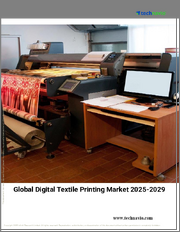
|
시장보고서
상품코드
1775561
디지털 날염 시장 : 예측(2025-2030년)Digital Textile Printing Market - Forecasts from 2025 to 2030 |
||||||
디지털 날염 시장은 CAGR 7.20%로, 2025년 43억 2,000만 달러에서 2030년에는 61억 1,500만 달러로 성장할 것으로 예측됩니다.
이 보고서는 세계 디지털 날염 시장을 종합적으로 분석하여 시장 동향, 기술 발전 및 경쟁 전략에 대한 중요한 인사이트를 업계 전문가에게 제공합니다. 이 조사는 디지털 인쇄 기술이 섬유 산업에 미치는 변혁적 영향을 조사하면서 인쇄 유형, 직물 유형, 최종사용자, 지역 등 주요 부문에 초점을 맞추고 있습니다. 디지털 텍스타일 프린팅 시장 조사는 시장 촉진요인, 억제요인, 최근 경쟁 동향을 밝힘으로써 패션, 인테리어, 산업용 섬유 이해관계자들에게 이 급성장하는 시장을 탐색할 수 있는 실용적인 정보를 제공합니다.
조사 개요
본 조사 보고서는 디지털 날염 시장을 유형별(다이렉트 프린트, 탈염 프린트, 레지스트 프린트, 안료 프린트, 기타), 직물 종류별(나일론, 폴리에스테르, 기타), 최종사용자별(텍스타일, 기업, 기타)로 상세히 조사 분석하고 있습니다. 맞춤형 지속가능한 섬유에 대한 수요 증가와 같은 시장 촉진요인뿐만 아니라, 높은 초기 설비 비용과 직물과 잉크의 호환성 문제 등 시장 억제요인에 대한 분석도 함께 이루어지고 있습니다. 북미, 남미, 유럽, 중동 및 아프리카, 아시아태평양 지역 분석과 함께 Porter's Five Forces 분석, 산업 밸류체인에 대한 인사이트, 전략적 제안, 중국, 인도 등 주요 시장에서의 성장 기회를 강조하고 있습니다.
경쟁 환경 및 분석
디지털 날염 시장 조사에서는 경쟁 환경 섹션에서 시장 성장을 주도하는 주요 기업의 전략적 혁신을 강조하고 있습니다. 최근 주요 기업들의 동향은 업계가 지속가능성과 효율성을 중시하고 있음을 강조하고 있습니다:
- Kornit Digital : 2024년, Kornit은 단일 단계 공정의 대용량 디지털 날염기 Apollo를 출시했습니다.
- Mimaki Engineering Co., Ltd. : 2024년 3월, 미마키는 열전사 공정을 사용하여 최소한의 폐수로 직물에 디자인을 인쇄하는 친환경 섬유 인쇄 시스템 TRAPIS를 발표했습니다. 이번 개발을 통해 미마키는 자동화와 사용자 친화적인 인터페이스를 강조하여 패션 분야의 중소기업에 대한 어필을 강화하고 있습니다.
디지털 날염 시장 조사에는 시장 점유율 분석과 함께 세이코 엡손의 2024년 Fiery, LLC 인수, 텍스타일 인쇄용 디지털 프론트엔드 서버 및 워크플로우 솔루션 강화 등 합병, 인수, 제휴에 대한 자세한 내용을 담고 있습니다. 되어 있습니다. 벤더 경쟁 역학 매트릭스는 이러한 역학을 명확하게 보여주고 업계 전문가가 시장 포지셔닝과 전략적 동향을 평가할 수 있도록 도와줍니다.
결론
디지털 날염 시장 조사 보고서는 디지털 날염 시장의 경쟁 상황과 기술 동향을 이해하고자 하는 업계 전문가에게 필수적인 자료입니다. Kornit Digital과 Mimaki와 같은 기업의 주요 발전 사항을 조명하고, 종합적인 세분화 및 지역별 인사이트와 함께 이해관계자들이 정보에 입각한 전략적 의사결정을 내릴 수 있도록 돕습니다. 지속가능한 맞춤형 섬유 솔루션에 대한 수요가 계속 증가하는 가운데, 디지털 텍스타일 프린팅 시장 역학은 역동적으로 진화하는 이 시장에서 기회를 활용할 수 있는 전략적 가이드를 제공합니다.
본 보고서의 주요 장점
- 통찰력 있는 분석 : 고객 부문, 정부 정책 및 사회경제적 요인, 소비자 선호도, 산업별, 기타 하위 부문에 초점을 맞춘 주요 지역 및 신흥 지역을 포괄하는 상세한 시장 분석을 얻을 수 있습니다.
- 경쟁 상황 : 세계 주요 기업들이 채택하고 있는 전략적 전략을 이해하고, 적절한 전략을 통한 시장 침투 가능성을 파악할 수 있습니다.
- 시장 동향과 촉진요인 : 역동적인 요인과 매우 중요한 시장 동향, 그리고 이들이 향후 시장 개척을 어떻게 형성할 것인지에 대해 알아봅니다.
- 실행 가능한 제안 : 역동적인 환경 속에서 새로운 비즈니스 스트림과 수익을 발굴하기 위한 전략적 의사결정에 인사이트를 활용합니다.
- 다양한 사용자에 대응 : 스타트업, 연구기관, 컨설턴트, 중소기업, 대기업에 유익하고 비용 효율적입니다.
어떤 용도로 사용되는가?
산업 및 시장 인사이트, 사업 기회 평가, 제품 수요 예측, 시장 진입 전략, 지리적 확장, 설비 투자 결정, 규제 프레임워크 및 영향, 신제품 개발, 경쟁의 영향
조사 범위
- 2022년부터 2024년까지의 과거 데이터와 2025년부터 2030년까지의 예측 데이터
- 성장 기회, 도전과제, 공급망 전망, 규제 프레임워크 및 동향 분석
- 경쟁사 포지셔닝, 전략 및 시장 점유율 분석
- 매출 성장 및 예측 국가를 포함한 부문 및 지역별 분석
- 기업 프로파일링(재무 정보, 주요 개발 등).
디지털 날염 시장 보고서가 다루는 다양한 부문은 다음과 같습니다:
유형별
- 다이렉트 프린트
- 탈염 프린트
- 레지스트 프린트
- 안료 프린트
- 기타
원단 종류별
- 나일론
- 폴리에스테르
- 기타
용도별
- 텍스타일
- 기업
- 기타
지역별
- 북미
- 미국
- 캐나다
- 멕시코
- 남미
- 브라질
- 아르헨티나
- 기타
- 유럽
- 영국
- 독일
- 프랑스
- 스페인
- 기타
- 중동 및 아프리카
- 사우디아라비아
- UAE
- 이스라엘
- 기타
- 아시아태평양
- 일본
- 중국
- 인도
- 한국
- 인도네시아
- 태국
- 기타
목차
제1장 소개
- 시장 개요
- 시장 정의
- 조사 범위
- 시장 세분화
- 통화
- 가정
- 기준 연도와 예측 연도 타임라인
제2장 조사 방법
- 조사 데이터
- 조사 설계
- 검증
제3장 주요 요약
- 조사 하이라이트
제4장 시장 역학
- 시장 성장 촉진요인
- 시장 성장 억제요인
- Porter's Five Forces 분석
- 업계 밸류체인 분석
제5장 디지털 날염 시장 : 유형별
- 소개
- 다이렉트 프린트
- 발염 프린트
- 레지스트 프린트
- 안료 프린트
- 기타
제6장 디지털 날염 시장 : 직물 종류별
- 소개
- 나일론
- 폴리에스테르
- 기타
제7장 디지털 날염 시장 : 최종사용자별
- 소개
- 섬유
- 기업
- 기타
제8장 디지털 날염 시장 : 지역별
- 소개
- 북미
- 미국
- 캐나다
- 멕시코
- 남미
- 브라질
- 아르헨티나
- 기타
- 유럽
- 영국
- 독일
- 프랑스
- 스페인
- 기타
- 중동 및 아프리카
- 사우디아라비아
- 아랍에미리트
- 이스라엘
- 기타
- 아시아태평양
- 일본
- 중국
- 인도
- 한국
- 인도네시아
- 태국
- 기타
제9장 경쟁 환경과 분석
- 주요 기업과 전략 분석
- 신흥 기업과 시장 수익성
- 합병, 인수, 합의 및 협업
- 벤더 경쟁력 매트릭스
제10장 기업 개요
- Mimaki
- Kornit
- SPGPrints
- Dover Corporation
- Robustelli
- SPG Prints B.V.
- Mutoh
The Digital Textile Printing Market is expected to grow from USD 4.320 billion in 2025 to USD 6.115 billion in 2030, at a CAGR of 7.20%.
The Digital Textile Printing Market Study provides a comprehensive analysis of the global digital textile printing market, offering industry experts critical insights into market trends, technological advancements, and competitive strategies. This study explores the transformative impact of digital printing technologies on the textile industry, focusing on key segments such as printing types, fabric types, end-users, and geographic regions. By highlighting market drivers, restraints, and recent competitive developments, the Digital Textile Printing Market Study equips stakeholders in fashion, home decor, and industrial textiles with actionable intelligence to navigate this rapidly growing market.
Study Overview
The Digital Textile Printing Market Study delivers an in-depth examination of the digital textile printing market, segmented by type (direct print, discharge print, resist print, pigment print, and others), fabric type (nylon, polyester, and others), and end-users (textile, enterprise, and others). It analyzes market drivers, such as the rising demand for customized and sustainable textiles, alongside restraints like high initial equipment costs and challenges in fabric-ink compatibility. The study incorporates Porter's Five Forces Analysis, industry value chain insights, and strategic recommendations, with regional breakdowns covering North America, South America, Europe, Middle East and Africa, and Asia Pacific, emphasizing growth opportunities in key markets like China and India.
Competitive Environment and Analysis
In the Digital Textile Printing Market Study, the competitive environment section highlights strategic innovations from key players driving market growth. Recent developments from leading companies underscore the industry's focus on sustainability and efficiency:
- Kornit Digital: In 2024, Kornit launched the Apollo, a high-volume digital textile printer with a single-step process, achieving up to 50% higher throughput than its predecessor, the Kornit Atlas. This innovation targets the apparel and home decor markets, offering sustainable printing with minimal water usage, strengthening Kornit's position in eco-friendly solutions.
- Mimaki Engineering Co., Ltd.: In March 2024, Mimaki introduced TRAPIS, an environmentally friendly textile printing system that uses a heat transfer process to print designs on fabric with minimal wastewater. This development enhances Mimaki's appeal to small and medium enterprises in the fashion sector, emphasizing automation and user-friendly interfaces.
The Digital Textile Printing Market Study also includes a market share analysis, detailing mergers, acquisitions, and collaborations, such as Seiko Epson's 2024 acquisition of Fiery, LLC, to enhance digital front-end servers and workflow solutions for textile printing. The vendor competitiveness matrix provides a clear view of these dynamics, enabling industry experts to assess market positioning and strategic trends.
Conclusion
The Digital Textile Printing Market Study is an essential resource for industry experts seeking to understand the competitive and technological landscape of the digital textile printing market. By spotlighting key developments from players like Kornit Digital and Mimaki, alongside comprehensive segmentation and regional insights, this study empowers stakeholders to make informed strategic decisions. As the demand for sustainable and customized textile solutions continues to rise, the Digital Textile Printing Market Study offers a strategic guide for capitalizing on opportunities in this dynamic and evolving market.
Key Benefits of this Report:
- Insightful Analysis: Gain detailed market insights covering major as well as emerging geographical regions, focusing on customer segments, government policies and socio-economic factors, consumer preferences, industry verticals, and other sub-segments.
- Competitive Landscape: Understand the strategic maneuvers employed by key players globally to understand possible market penetration with the correct strategy.
- Market Drivers & Future Trends: Explore the dynamic factors and pivotal market trends and how they will shape future market developments.
- Actionable Recommendations: Utilize the insights to exercise strategic decisions to uncover new business streams and revenues in a dynamic environment.
- Caters to a Wide Audience: Beneficial and cost-effective for startups, research institutions, consultants, SMEs, and large enterprises.
What do businesses use our reports for?
Industry and Market Insights, Opportunity Assessment, Product Demand Forecasting, Market Entry Strategy, Geographical Expansion, Capital Investment Decisions, Regulatory Framework & Implications, New Product Development, Competitive Intelligence
Report Coverage:
- Historical data from 2022 to 2024 & forecast data from 2025 to 2030
- Growth Opportunities, Challenges, Supply Chain Outlook, Regulatory Framework, and Trend Analysis
- Competitive Positioning, Strategies, and Market Share Analysis
- Revenue Growth and Forecast Assessment of segments and regions including countries
- Company Profiling (Strategies, Products, Financial Information, and Key Developments among others.
Different segments covered under the digital textile printing market report are as below:
By Type
- Direct Print
- Discharge Print
- Resist Print
- Pigment Print
- Others
By Fabric Type
- Nylon
- Polyester
- Others
By End-User
- Textile
- Enterprise
- Others
By Geography
- North America
- United States
- Canada
- Mexico
- South America
- Brazil
- Argentina
- Others
- Europe
- United Kingdom
- Germany
- France
- Spain
- Others
- Middle East and Africa
- Saudi Arabia
- UAE
- Israel
- Others
- Asia Pacific
- Japan
- China
- India
- South Korea
- Indonesia
- Thailand
- Others
TABLE OF CONTENTS
1. INTRODUCTION
- 1.1. Market Overview
- 1.2. Market Definition
- 1.3. Scope of the Study
- 1.4. Market Segmentation
- 1.5. Currency
- 1.6. Assumptions
- 1.7. Base, and Forecast Years Timeline
2. RESEARCH METHODOLOGY
- 2.1. Research Data
- 2.2. Research Design
- 2.3. Validation
3. EXECUTIVE SUMMARY
- 3.1. Research Highlights
4. MARKET DYNAMICS
- 4.1. Market Drivers
- 4.2. Market Restraints
- 4.3. Porter's Five Forces Analysis
- 4.3.1. Bargaining Power of Suppliers
- 4.3.2. Bargaining Power of Buyers
- 4.3.3. Threat of New Entrants
- 4.3.4. Threat of Substitutes
- 4.3.5. Competitive Rivalry in the Industry
- 4.4. Industry Value Chain Analysis
5. DIGITAL TEXTILE PRINTING MARKET BY TYPE
- 5.1. Introduction
- 5.2. Direct Print
- 5.3. Discharge Print
- 5.4. Resist Print
- 5.5. Pigment Print
- 5.6. Others
6. DIGITAL TEXTILE PRINTING MARKET BY FABRIC TYPE
- 6.1. Introduction
- 6.2. Nylon
- 6.3. Polyester
- 6.4. Others
7. DIGITAL TEXTILE PRINTING MARKET BY END-USER
- 7.1. Introduction
- 7.2. Textile
- 7.3. Enterprise
- 7.4. Others
8. DIGITAL TEXTILE PRINTING MARKET BY GEOGRAPHY
- 8.1. Introduction
- 8.2. North America
- 8.2.1. United States
- 8.2.2. Canada
- 8.2.3. Mexico
- 8.3. South America
- 8.3.1. Brazil
- 8.3.2. Argentina
- 8.3.3. Others
- 8.4. Europe
- 8.4.1. United Kingdom
- 8.4.2. Germany
- 8.4.3. France
- 8.4.4. Spain
- 8.4.5. Others
- 8.5. Middle East and Africa
- 8.5.1. Saudi Arabia
- 8.5.2. UAE
- 8.5.3. Israel
- 8.5.4. Others
- 8.6. Asia Pacific
- 8.6.1. Japan
- 8.6.2. China
- 8.6.3. India
- 8.6.4. South Korea
- 8.6.5. Indonesia
- 8.6.6. Thailand
- 8.6.7. Others
9. COMPETITIVE ENVIRONMENT AND ANALYSIS
- 9.1. Major Players and Strategy Analysis
- 9.2. Emerging Players and Market Lucrativeness
- 9.3. Mergers, Acquisitions, Agreements, and Collaborations
- 9.4. Vendor Competitiveness Matrix
10. COMPANY PROFILES
- 10.1. Mimaki
- 10.2. Kornit
- 10.3. SPGPrints
- 10.4. Dover Corporation
- 10.5. Robustelli
- 10.6. SPG Prints B.V.
- 10.7. Mutoh



















